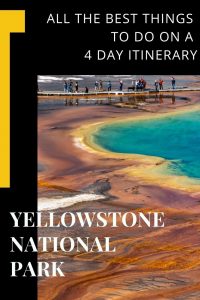Last Updated on 12/08/21 by Rose Palmer
I’ve been fortunate to be able to visit Yellowstone National Park a number of times in the last few years. A couple of times were in September, which I think is an ideal time to visit the park – the weather was pleasant and the park was not as crowded as it gets during the summer months. Mid to late September also has the added advantage of seeing the aspen and cottonwood trees turn gold. On my first trip to Yellowstone, I planned a detailed 4 day Yellowstone itinerary which I am sharing here.
The development of the National Park System has been called America’s best idea. Regardless of whether you agree or disagree with this statement, it has certainly become a model for preservation and conservation of natural beauty, scenery and wildlife around the world.
As America’s first National Park dedicated in 1872, Yellowstone protects one of the largest volcanoes on earth which erupted about 640,000 years ago and created the 45 mile wide caldera through which I was sight seeing.
Though it is now considered a dormant volcano, the geology is still active and over half of the world’s geysers and hydrothermal features are located in this park. This unique ecosystem was also named a UNESCO World Heritage Site in 1978.

Yellowstone National Park protects an area of 3.5 thousand square miles which is larger than the states of Rhode Island or Delaware. With such a large area to cover, I found that my 4 days in Yellowstone was the minimum amount of time to see the major highlights of this vast and diverse landscape. And since Yellowstone National Park is so huge, I preferred to stay at accommodations inside the park to maximize the amount of time I spent seeing the sights.
My 4 Day Yellowstone Itinerary
My Yellowstone itinerary followed the Grand Loop Road in a counterclockwise direction. I started at the southern entrance coming from Grand Teton National Park, then drove to Old Faithful, Norris Geyser Basin, Mammoth Hot Springs, Grand Canyon of the Yellowstone and finished at Lake Yellowstone.
After finishing my two day tour of Grand Teton National Park, I stayed at the Headwater’s Lodge and Cabins at Flagg Ranch which is less than a 10 minute drive from the south entrance to Yellowstone National Park. I had the following Yellowstone 4 day itinerary planned:
Day 1 – Enter the park from the south entrance and explore West Thumb, Old Faithful and Upper Geyser Basin, Black Sand Basin, view the sunset from Firehole Lake Drive; stay in the Old Faithful area.
Day 2 – Drive from the Old Faithful area to Mammoth Hot Springs. Explore Biscuit Basin, Midway Geyser Basin, Fountain Paint Pots, Firehole Canyon Drive, Artists Paint Pots, Norris Geyser Basin; stay at Mammoth Hotel and Cabins.
Day 3 – Explore the Mammoth Hot Springs area and Lamar Valley; drive some of the Beartooth highway; stay at Roosevelt Lodge and Cabins.
Day 4 – Explore the Grand Canyon of the Yellowstone, Hayden Valley, Lake Yellowstone; stay at Lake Yellowstone
How to spend 4 days in Yellowstone
Day 1
West Thumb
I got a very early start and after entering Yellowstone Park from the south entrance, headed to the West Thumb Geyser Basin which is on the shores of Lake Yellowstone, and which was the first geothermal area that I came to.
I was particularly interested in catching the sunrise over the lake from this vantage point. A boardwalk took me past a variety of thermal features that are both on land and in the lake. This area was particularly scenic as the sun rose through the low mist and steam.
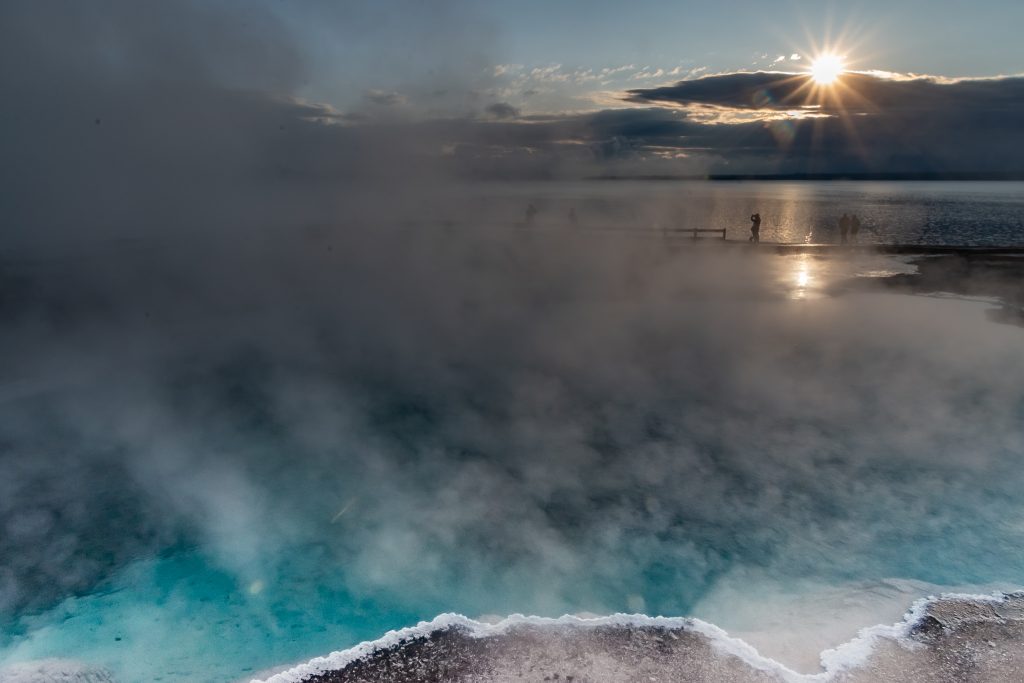
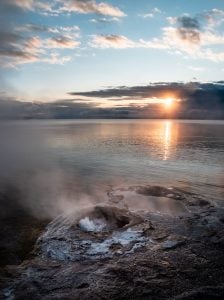
From West Thumb, I continued driving north to the Old Faithful area.
Old Faithful
The Old Faithful geyser is the star of Yellowstone Park and is on everyone’s must see list. It is not necessarily the biggest geyser in Yellowstone, or the most impressive – though it is quite impressive. But what it has going for it that none of the others do is that it is pretty “faithful” in its eruption schedule. About every 90 minutes (give or take about 15 minutes or so), you can count on seeing a huge stream of hot water blast into the sky accompanied by lots of steam and spurting noises.
This is also one of the easiest geysers to see with the least amount of effort. All three of the Old Faithful hotels are situated in a semicircle around Old Faithful, so if you are staying at any of these lodges, you can most likely see Old Faithful’s eruption many times.
There are also many benches around the boardwalk which makes waiting quite comfortable as long as you get there early enough to get a seat. This is the most popular spot in the park so expect it to be quite busy.
When it erupts, Old Faithful is visible from many parts of the boardwalk around the Upper Geyser Basin, so I was able to see it from a a number of vantage points as I walked around the area.
I especially liked seeing Old Faithful erupt at night without anyone else around. So if you are staying here, don’t miss seeing this classic geyser spout once the sun has set, especially if the moon is out, for a different and much quieter experience.

Upper Geyser Basin
Old Faithful is only one of the geysers in the Upper Geyser basin. Trails and boardwalks make it easy to explore this area that is so rich in geothermal activity. The greatest concentration of the park’s geothermal activity is found here. In a one square mile area, there are over 150 thermal features that include geysers of all shapes and sizes and big and small colorful hot springs
I stopped at the Old Faithful Visitor’s Center and made a note of the predicted times for the next eruptions. Rangers make predictions for five geysers in this area: Old Faithful, Castle, Grand, Daisy and Riverside. I think it’s worth taking the time to wait and see at least one or two of these geysers erupt.



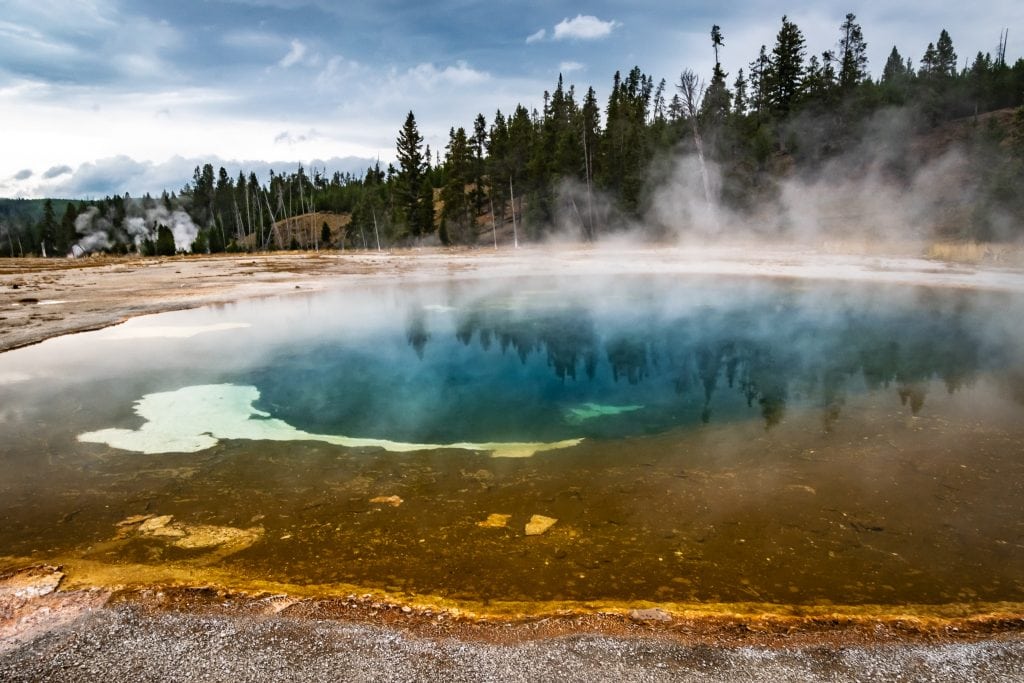
I timed my walk around the Upper Geyser basin so that I could be in the area when the Daisy Geyeser was supposed to erupt. She went off a little early, but I still managed to see a fair bit of the eruption.
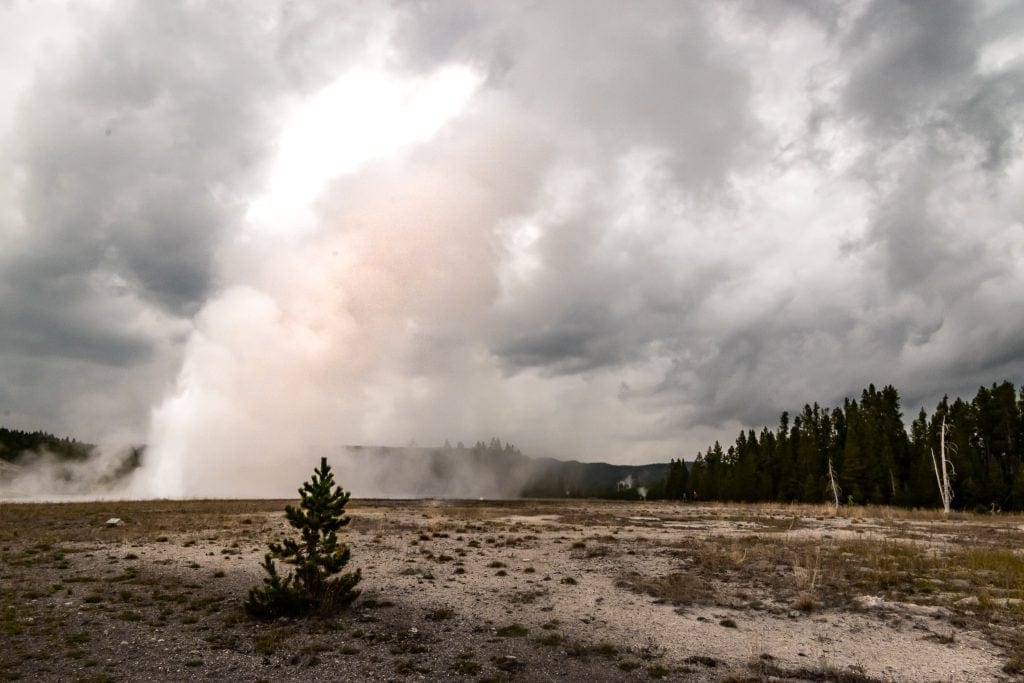
I also managed to catch some of the Riverside Geyser eruption.

To get a different bird’s eye view of the old Faithful area and the Upper Geyser Basin you can also took the short uphill hike to Observation Point.
Black Sand Basin
About a mile north of Old Faithful is the Black Sand Basin which has a few very colorful pools. It was a short and easy hike on boardwalks around the various features.
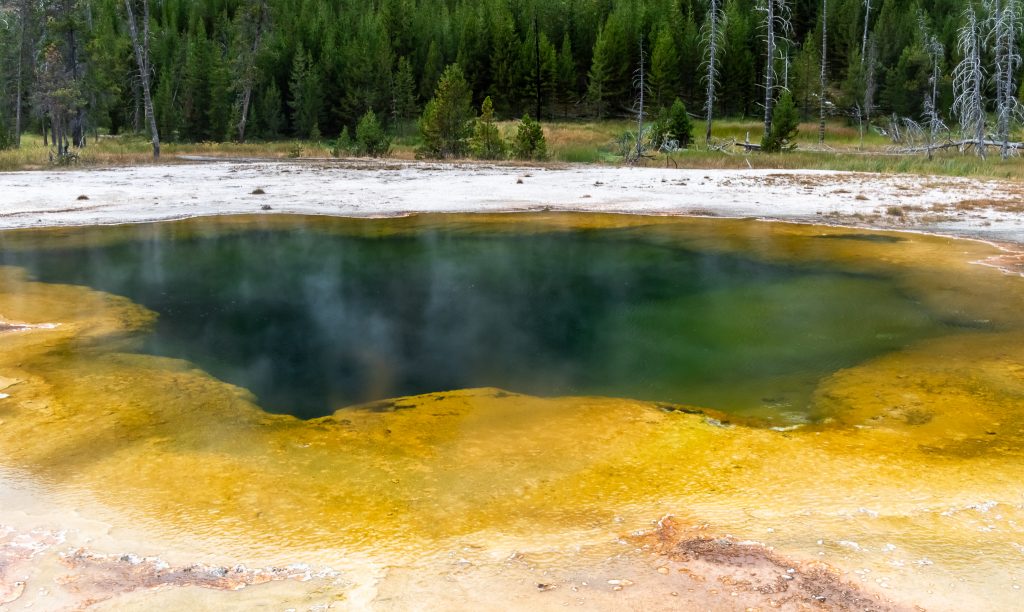
Firehole Drive
I finished my day 1 Yellowstone itinerary with a drive and stop on Firehole Drive, which is about 8 miles north of Old Faithful. I found this drive to be particularly scenic at sunset, especially with the clouds dramatically colored by the setting sun.

I scheduled my visit around the time when the Great Fountain Geyser was supposed to blow, but the eruption had a plus or minus one hour time window. I patiently waited over an hour until it got too dark to see, but to no avail. It only spurted steam while I was there. But with the sunset reflecting in the pools around the geyser, it was still a beautiful sight.


Old Faithful Inn
Completed in 1904 the famous Old Faithful Inn still remains the largest log building in the world. The lodgepole pines and all the stone came from the nearby area of the park to build this, the first of the great park lodges in the west.
Despite its rustic appearance, the electricity and steam heat are original to the building. I thoroughly enjoyed one of the daily Old Faithful Inn history tours that provided lots of interesting tidbits of information about this National Historic Landmark.

To feel totally embraced by the history of this structure, I chose to stay in one of the rooms in the original part of the hotel (called the Old House). My bathroom was down the hall, but staying in a room where the original log walls glowed with the patina of 100 years of use gave me a more authentic experience of this building that inspired the style known as National Park Service Rustic.
One of the best views of Old Faithful is from the outdoor second level balcony of the Inn.

Day 2
Biscuit Basin
Continuing north from the Old Faithful area, I started the day with a tour of the thermal features in the Biscuit Basin. Boardwalks here took me to a number of sights, the most colorful being the beep blue Saphire Pool.
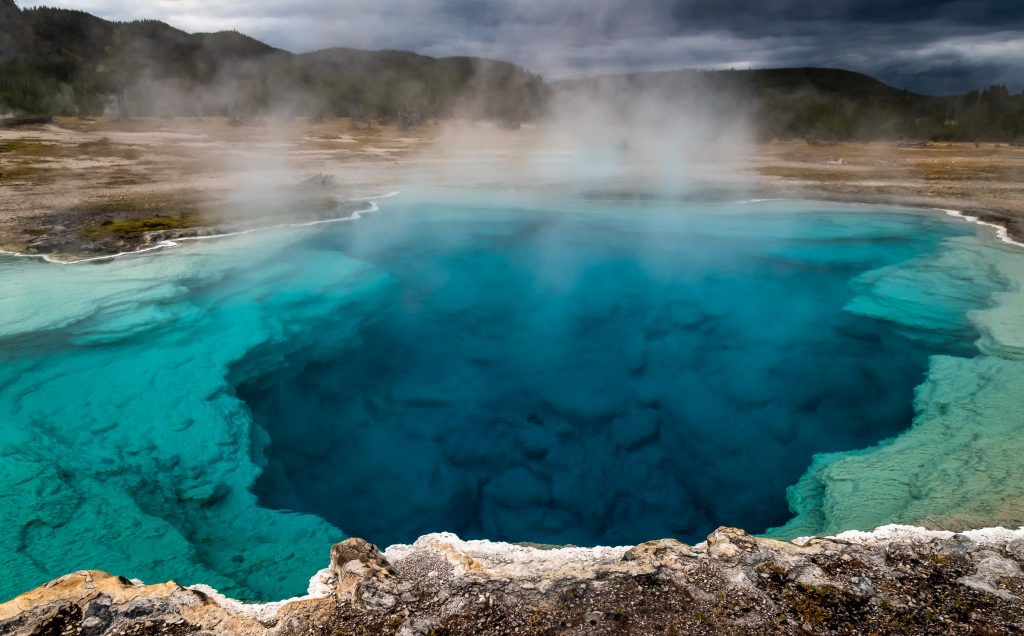
Midway Geyser Basin
A little further on is the Middle Geyser Basin with the very photogenic Grand Prismatic Spring. Popular photos of this colorful pool show it from a bird’s eye view. You will not be able to see it like that.
There is an uphill trail that I took to an overlook of the Grand Prismatic spring that gave me a distant view looking at it from the side. (The trail starts at the Fairy falls Parking lot). From this height, I was able to see and appreciate the different colored circles that surrounded this spring. The colored mats of bacteria that encircle this pool indicate the temperature of the water.


The Grand Prismatic Spring is the second largest in the world, and a boardwalk let me walk around a large part of it. From this level it is hard to see the individual rings of color, but instead, I had up close views of the large mats of colorful bacteria.

Fountain Paint Pots
Continuing north just past the Firehole Lake Drive is the Fountain Paint Pots thermal area. Here you can experience all four of the park’s hydrothermal features: fumaroles, hot springs, geysers and mud pots.
Firehole Canyon Drive
The detour onto Firehole Canyon Drive was well worth the time. The drive took me past a viewing area for the scenic 40 ft Firehole Falls.

Artists Paint Pots
A little further on, a short trail climbs up a hillside for a birds eye view of the Artists Paint Pot hydrothermal area. This feature got its name from the colorful mud pots and pools that dot the geology here.
Once I reached the Madison Junction, I continued on toward the Norris Junction.
Norris Geyser Basin
At Norris Geyser Basin, you’ll experience the oldest and hottest part of the ancient caldera that underlies all of this thermal activity at Yellowstone. There were two areas here to explore. The Porcelain Basin is barren and very active and is accessible by a 3/4 mile boardwalk trail.


In contrast, the Back Basin is more heavily wooded and it is here where you will find Steamboat Geyser, which produces the world’s highest (though quite unpredictable) geyser eruption. The day I was there, volunteer geyser spotters were patiently sitting – in the rain – waiting for Steamboat to blow its top. Apparently it had been showing some activity for the past few days which was an indicator of an imminent eruption (imminent meaning in an hour, a day or a week).


From Norris I continued driving north to the Mammoth Hot Springs area where I had dinner and spent the night in one of the historic cabins.
Day 3
Mammoth Hot Springs
If you are lucky, you will see the elk herd that likes to hang out around the Mammoth Hot Springs Hotel. In the fall, the males can get aggressive during the rut, so make sure you keep your distance.


I spent the morning exploring the Lower Terrace and Upper Terrace at the Mammmoth Hot Springs. You can drive to the upper terraces but getting a parking spot can be a challenge and I found it easier to just take one of the boardwalk paths up there.
The hot springs here have very high concentrations of dissolved limestone. As the hot water trickles over the surface, it continuously deposits calcium carbonate which forms the many travertine terraces.
Lamar Valley
After a good lunch at the Terrace Grill at the Mammoth Hot Springs Resort, I continued east to Lamar Valley. The Lamar valley is one of the park’s best regions to see wildlife. This is a good place to be on the lookout for bison, bear, elk, mule deer, pronghorn and potentially even wolves. If there is a car jam blocking the road, you can bet there is an animal sighting nearby.
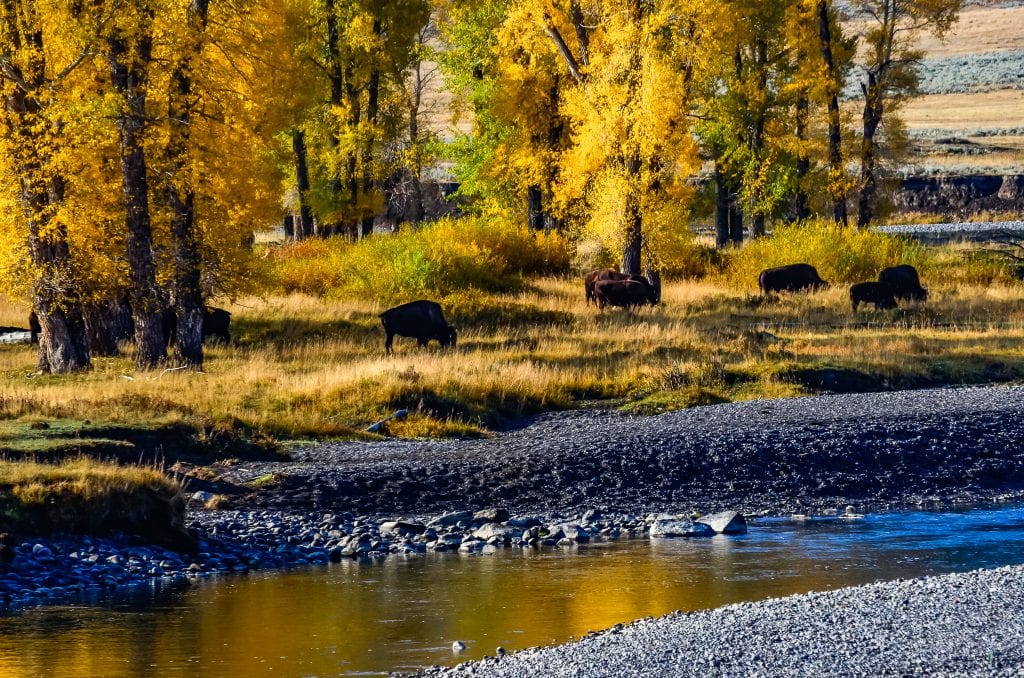
Be sure to follow the park guideline for viewing wildlife. Stay at least 100 yards away from bears and wolves and 25 yards from all other animals. This is where telephoto lenses are definitely necessary.

One of the best ways to see wildlife is to pull over in one of the parking areas or pull offs (near an open field if possible) and just sit and wait and keep an eye out for the animals. A good pair of binoculars will also be very useful.
Even without any wildlife, the scenery here is magnificent, especially toward the end of September when the fall colors erupt.

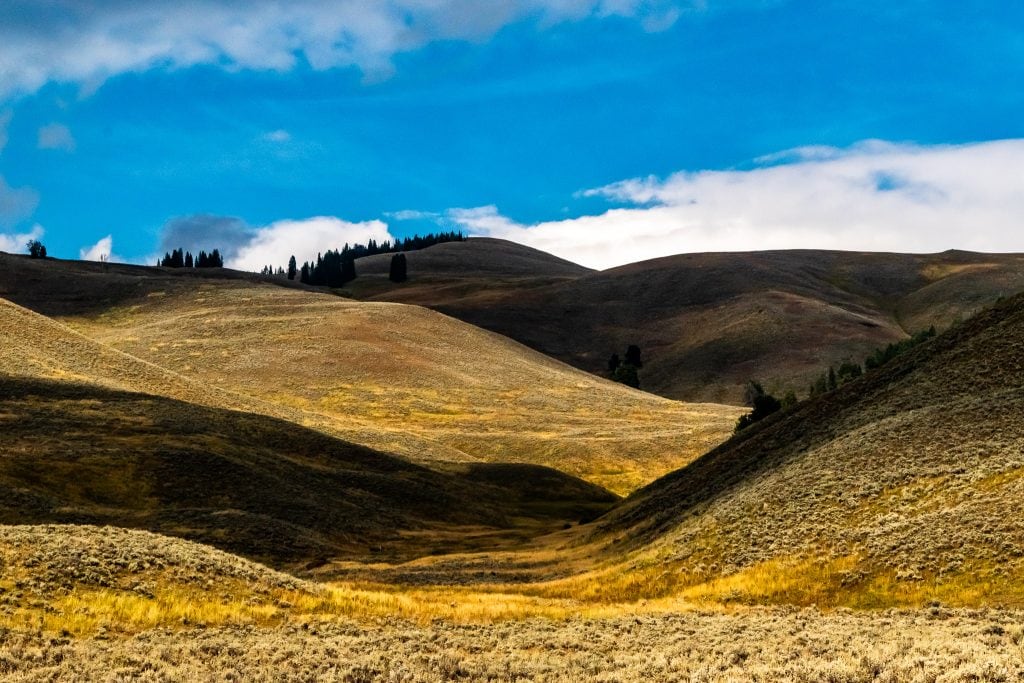
Beartooth Highway
I exited the park at Cooke city and continued on route 212 toward Red Lodge. This stretch of the road is called the Beartooth Highway, and is designated a National Scenic Byway “All American Road” which means that it is really, really scenic. The road climbed 5000 feet along easy to drive switchbacks and passed glacial carved valleys and sparkling mountain lakes.
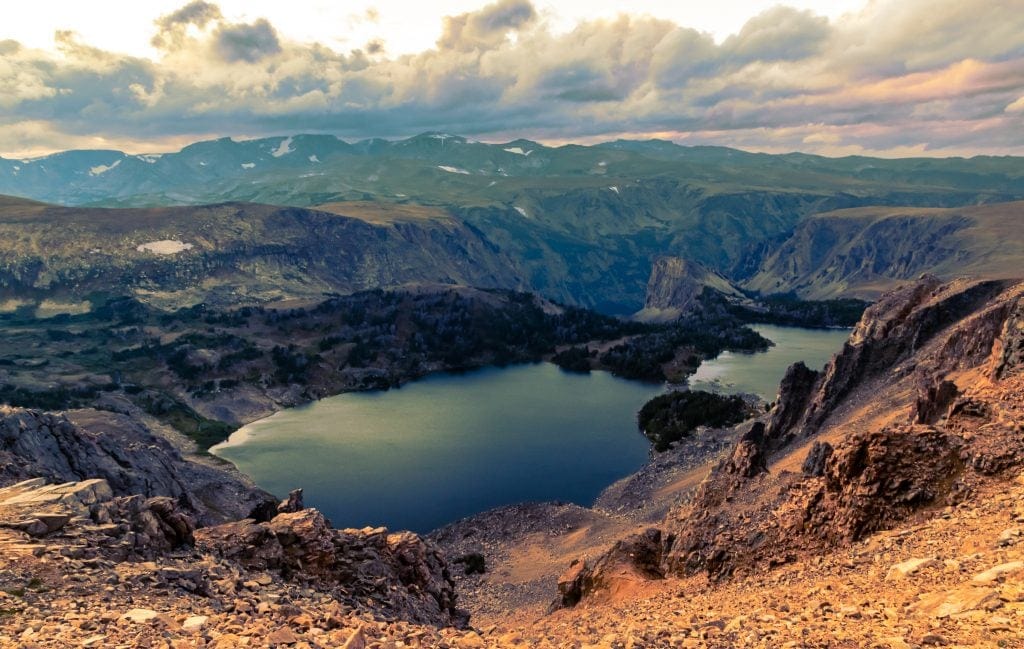
It was hard not to stop around every bend to take yet more photos of the stunning Rocky Mountain peaks, though the sun was setting and I did not have the best light.

At Beartooth Pass (10,947 feet) I turned around since it was starting to get dark and headed back into Yellowstone and the Roosevelt Lodge to spend the night. (Alternatively, if you are driving the Beartooth Highway, you could also stay in Cooke City or Red Lodge).
If you are driving the Beartooth highway after mid September, be sure to keep an eye on the weather as well. The day after I drove it, there was a snow storm at the higher elevations.
Day 4
Grand Canyon of the Yellowstone
Another early start got me to the Grand Canyon of the Yellowstone before most of the crowds. This is another of the very popular spots in the park which can get quite busy. Early morning is also a good time to photograph in this area because the morning sun lights up the canyon and the falls.
I started with the South Rim drive to Artists Point. Here I got the classic view of the canyon and the Lower Falls.
If you have the stamina for the climb back up, the 328 stair Uncle Tom’s trail takes you to a wonderful up close vantage point of the Lower Falls. Remember that you are at 8000 feet altitude here, so the hike will be more strenuous than usual.
Next up was a drive along the north rim of the canyon to views of the Upper Falls and then on to Inspiration Point for a different perspective of the canyon and the Lower Falls

Hayden Valley
South of Canyon Village, the Grand Loop Road passes through the Hayden valley, which is another great area for wildlife viewing. There are many pull offs here, but a bison crossing the road will creating a traffic jam and stop traffic in its tracks.

Mud Volcanoes
As the name implies, the hydrothermal features here are primarily mud pots and fumaroles. You’ll smell a strong rotten egg odor as the bacteria break down the high concentrations of sulfuric acid to produce hydrogen sulfide.


Yellowstone Lake
Lake Yellowstone is one of the largest high elevation lakes in North America and is centered over the caldera that was formed when the volcano last erupted. There are a number of scenic pull offs on the drive around the lake which make great picnic and photo spots. There is also a scenic cruise on the lake that is an option for a different perspective.


The Lake Yellowstone Hotel is actually the oldest hotel in the park having been built in 1891. You can learn all about the history of this hotel on one of the daily tours. A meal and a night at this historic hotel is a classy and relaxing way to finish a Yellowstone vacation.
And make sure to check out the sunset over the lake for a memorable way to finish a perfect 4 days in Yellowstone itinerary.
More tips for visiting Yellowstone National Park
- Make reservations for accommodations inside the park as far in advance as possible – even up to a year if you can – especially for the prime summer vacation months.
- If you cannot stay in the park, there are many lodging options in the gateway towns of West Yellowstone, Gardiner, Cooke City and Cody, though you will be spending a lot more time driving into and out of the park.
- The major lodging resorts in the park (Old Faithful, Mammoth Hot Springs, Canyon Village, Grant Village and Lake Village) have restaurants where you can get a variety of food options and drinks. You can also fill up your gas tank at these locations.
- To have greater sightseeing flexibility during the day, I like to have some picnic supplies on hand. Before entering the park, I stopped at a grocery store and picked up supplies for easy lunches that could survive without constant refrigeration (salami, hard cheeses, crackers, fruit, carrots, granola bars, nuts).
- The park was not as busy in September as is it is in the prime summer months. That said, I still had trouble finding parking at some of the popular spots by mid afternoon. Getting an early start let me enjoy some of the sights before the crowds (another advantage to staying in the park).
- WiFi connectivity is extremely limited in the park, even at the hotels. Don’t count on using your phone GPS or Google maps to get around. You’ll want to pick up and use a paper park map or print a map at home and take it with you.
- The hotels and the park offer a variety activities, tours and things to do (like the free tour of Old Faithful Inn that I took). Try to a allow time and build those in o your time here.
- Not that you have any control over the weather, but the colorful pools and the travertine terraces look most vibrant on a sunny day.
- Keep your distance from the animals. The National Park guidelines are 100 yards from bears and wolves and 25 yards from all other animals.
- It goes without saying that you need to stay on the boardwalks and marked trails. These are called thermal features because the water is HOT – don’t test that out. Visitors get burned at Yellowstone every year – don’t be one them.
- It also goes without saying that nothing should be thrown into any of the geysers, hot springs, fumaroles or mud pots. While this seems like common sense, there are numerous signs reminding folks not to do this- because apparently some people do.
I hope you find this guide and itinerary for Yellowstone National Park useful. With only four days in the park this schedule worked for me to see the major sights. I could easily have spent several more days though, taking time to do more hikes and enjoying the lodges.
You can also read my full post with tips on how to best plan a trip to Yellowstone.
I suggest studying the map of Yellowstone NP before your visit:https://www.nps.gov/yell/planyourvisit/upload/YELL_Tear-Off_Map2016.
Yellowstone is not open all year. The official Yellowstone National Park website is the best resource for the most up to date information about the park, including when it is open, where to stay and eat, and what to do: https://www.nps.gov/yell/index.htm
Thanks for visiting.
Rose
Pin this!
























